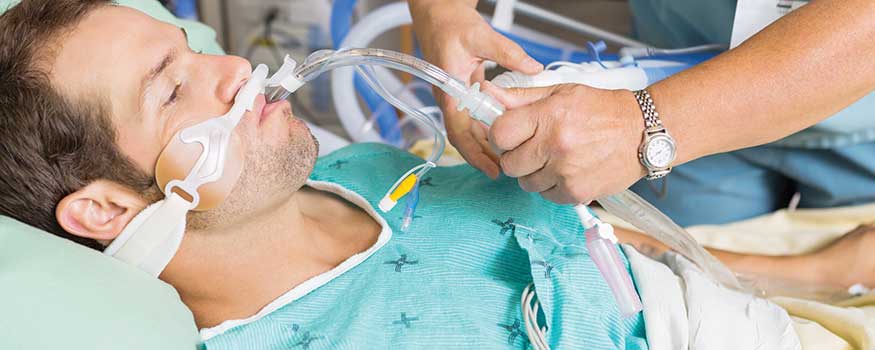Key takeways
|
Healthcare-associated infections, such as ventilator-associated pneumonia (VAP), are the most common and most preventable complication of a patient’s hospital stay. Their frequency and potential adverse effects increase in critically ill patients because of impaired physiology, including a blunted immune response and multi-organ dysfunction.
Traditionally, VAP rates have been measured as an indicator of quality of care. Despite recent initiatives to measure complications of mechanical ventilation and a decrease in incidence over the past few years, VAP remains an issue for critically ill adults, with mortality estimated as high as 10%.
This article reviews the top five evidence-based nursing practices for reducing VAP risk in critically ill adults.
1 Minimize ventilator exposure
The most important evidence-based practice for lowering VAP risk is minimizing a patient’s exposure to mechanical ventilation, which can be achieved in two ways.
First, encourage and advocate for the use of noninvasive ventilation approaches, such as bilevel positive airway pressure or continuous positive airway pressure. The face masks used with these approaches can be uncomfortable for patients, but data from a small randomized clinical trial suggests that similar benefits can be achieved using a helmet instead. In addition to better patient comfort, helmets resulted in a significantly lower intubation rate compared to face masks.
Second, when mechanical ventilation can’t be avoided, work to minimize its duration. Ventilator-weaning protocols or evidence-based care bundles (for example, the Awakening, Breathing Coordination, Delirium, and Early mobility [ABCDE] bundle) can be effective in shortening mechanical ventilation duration. Nurse-led and respiratory therapist–led ventilator-weaning protocols that include daily interruption of sedation and coordination with a spontaneous breathing trial have been effective in removing patients from mechanical ventilation quickly and appropriately. If a ventilator-weaning protocol doesn’t exist on your unit, take the opportunity to design and develop one.
2 Provide excellent oral hygiene care
Oral health quickly deteriorates in mechanically ventilated patients. Some patients sustain injuries to the oral mucosa during the intubation procedure, and after intubation, patients are prone to dry mouth. These factors, in addition to a severely compromised immune system, can cause an increase in bacteria colonization in the oral mucosa, with the endotracheal tube serving as a direct route to the lungs.
Adequate oral care can reduce bacterial overgrowth and reduce the risk for infection. In a meta-analysis of more than 18 randomized controlled trials (RCTs), routine oral care with chlorhexidine reduced the incidence of VAP. Currently, no guidelines exist for oral hygiene frequency. A recent systematic review of 38 RCTs showed oral care being performed anywhere from one to four times a day.
Making oral care a routine part of a patient’s assessment in the intensive care unit (ICU) is one way to enhance its frequency. Consider developing a unit-specific protocol with clear articulation of roles and responsibilities.
3 Coordinate care for subglottic suctioning
Aspiration of secretions that accumulate around a mechanically ventilated patient’s endotracheal tube can lead to VAP. Subglottic secretion suctioning can be performed by both the nurse and respiratory therapist to help prevent aspiration and subsequent VAP. A recent meta-analysis of 20 RCTs found that subglottic suctioning reduced the risk for VAP by 45% compared to patients who didn’t receive this suctioning. Coordinating subglottic suctioning when conducting oral care may be a good way to cluster care and ensure both practices are routinely delivered.
4 Maintain positioning and encourage mobility
To reduce gastric reflux and aspiration, which can lead to VAP in mechanically ventilated patients, keep the head of the bed elevated between 30 and 45 degrees (semirecumbent position).
Early mobility can be challenging, but it results in more ventilator- free days. Evidence supports the feasibility of early mobilization for critically ill patients, even shortly after intubation, as long as the patient isn’t sedated. Early-mobility protocols include a progressive approach that transitions from dangling at the edge of the bed, to standing at the edge of bed, to marching in place, and then, for patients who can tolerate a higher level of activity, ambulating. For the best patient outcomes, coordinate exercise and mobilization with physical and occupational therapists.
5 Ensure adequate staffing
Adequate nurse staffing in the ICU, especially for mechanically ventilated patients, can help minimize VAP risk. It provides nurses with the time, opportunity, and resources to implement care practices that reduce risk, and it allows them to spend more time with their patients, which may lead to early identification of VAP and prompt treatment.
Healthy work environments and interprofessional collaboration have been associated with lowering the risk for VAP. Two studies found that better nurse work environments, in conjunction with physician staffing, have implications for VAP risk. For example, in open ICUs where patients are managed by general physicians instead of specially trained critical care physicians, good nurse work environments can reduce VAP rates for mechanically ventilated patients.
Similarly, when nurses work in environments that support professional nursing practice (healthy nurse work environments), they are significantly less likely to report frequent VAP. These data provide support for you to collaborate with other nurses to ensure a supportive work environment. For example, develop shared governance models, engage in quality-improvement activities to enhance high-quality care, and encourage positive team interactions. Partnering with ICU physicians and the rest of the interprofessional team, especially respiratory therapists, is key to encouraging positive team interactions and reducing VAP risk.
Nurses perfectly positioned
Nurses are particularly well positioned to lead the healthcare team in VAP prevention. You can help minimize patients’ exposure to mechanical ventilation, work collaboratively to develop a ventilatorweaning protocol, and ensure implementation of evidence-based care that minimizes VAP risk.
All of the authors work at the University of Michigan in Ann Arbor. Emily Boltey is a doctoral (PhD) student in the Department of Systems, Populations and Leadership at the School of Nursing; Olga Yakusheva is an associate professor in the Department of Systems, Populations and Leadership at the School of Nursing and Department of Health Management & Policy in the School of Public Health and a member of the Institute for Healthcare Policy & Innovation; and Deena Kelly Costa is an assistant professor in the Department of Systems, Populations and Leadership at the School of Nursing and a member of the Institute for Healthcare Research and Quality. Funding for this work was provided by the Agency for Healthcare Research & Quality (K08 HS024552, PI Costa).
Selected references
Balas MC, Vasilevskis EE, Olsen KM, et al. Effectiveness and safety of the awakening and breathing coordination, delirium monitoring/management, and early exercise/mobility bundle. Crit Care Med. 2014;42(5):1024-36.
Blackwood B, Alderdice F, Burns K, Cardwell C, Lavery G, O’Halloran P. Use of weaning protocols for reducing duration of mechanical ventilation in critically ill adult patients: Cochrane systematic review and meta-analysis. BMJ. 2011;342:c7237.
Cimiotti JP, Aiken LH, Sloane DM, Wu ES. Nurse staffing, burnout, and health care-associated infection. Am J Infect Control. 2012;40(6):486-90.
Costa DK, Yang JJ, Manojlovich M. The critical care nurse work environment, physician staffing, and risk for ventilator-associated pneumonia. Am J Infect Control. 2016;44(10):1181-3.
Ely EW, Meade MO, Haponik EF, et al. Mechanical ventilator weaning protocols driven by nonphysician health-care professionals: Evidence-based clinical practice guidelines. Chest. 2001;120(suppl 6):454S-63S.
Hua F, Xie H, Worthington HV, Furness S, Zhang Q, Li C. Oral hygiene care for critically ill patients to prevent ventilator-associated pneumonia. Cochrane Database Syst Rev. 2016;10.
Kelly D, Kutney-Lee A, Lake ET, Aiken LH. The critical care work environment and nurse-reported health care-associated infections. Am J Crit Care. 2013;22(6):482-8.
Li Bassi G, Senussi T, Aguilera Xiol E. Prevention of ventilator-associated pneumonia. Curr Opin Infect Dis. 2017;30(2):214-20.
Mao Z, Gao L, Wang G, et al. Subglottic secretion suction for preventing ventilator-associated pneumonia: An updated meta-analysis and trial sequential analysis. Crit Care. 2016;20(1):353.
Patel BK, Wolfe KS, Pohlman AS, Hall JB, Kress JP. Effect of noninvasive ventilation delivered by helmet vs face mask on the rate of endotracheal intubation in patients with acute respiratory distress syndrome: A randomized clinical trial. JAMA. 2016;315(22):2435-41.
Schweickert WD, Pohlman MC, Pohlman AS, et al. Early physical and occupational therapy in mechanically ventilated, critically ill patients: A randomised controlled trial. Lancet. 2009;373(9678):1874-82.
Speck K, Rawat N, Weiner NC, Tujuba HG, Farley D, Berenholtz S. A systematic approach for developing a ventilator-associated pneumonia prevention bundle. Am J Infect Control. 2016;44(6):652-6.


















